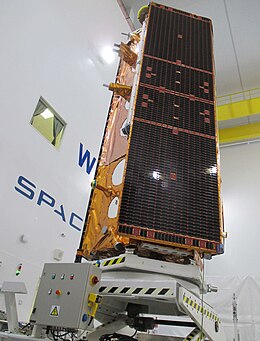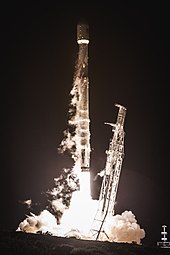Paz (satellite)
 Paz undergoing integration at SpaceX prior to launch | |
| Names | SEOSAR |
|---|---|
| Mission type | Earth observation Reconnaissance Intelligence |
| Operator | Hisdesat |
| COSPAR ID | 2018-020A |
| SATCAT no. | 43215 |
| Mission duration | Planned: ≥7 years Elapsed: 7 years, 1 month, 11 days |
| Spacecraft properties | |
| Manufacturer | Airbus Defence and Space |
| Launch mass | 1,341 kg (2,956 lb) |
| Dry mass | 1,282 kg (2,826 lb) |
| Dimensions | Hexagonal: 2.4 × 5 m (7.9 × 16.4 ft) |
| Power | 850 W |
| Start of mission | |
| Launch date | 22 February 2018, 14:17 SLC-4E |
| Contractor | SpaceX |
| Orbital parameters | |
| Reference system | Geocentric |
| Regime | Low Earth |
| Perigee altitude | 507.2 km (315.2 mi) |
| Apogee altitude | 509.5 km (316.6 mi) |
| Inclination | 97.45° |
| Period | 94.79 minutes |
| Epoch | 20 September 2018, 07:51:55 UTC[1] |
| Transponders | |
| Band | X band |
| Bandwidth | 300 Mbits/sec |
Paz (Spanish for "Peace") is a Spanish Earth observation and reconnaissance satellite launched on 22 February 2018. It is Spain's first spy satellite.[2] The satellite is operated by Hisdesat.[3] Paz was previously referred to as SEOSAR (Satélite Español de Observación SAR).[4]
Overview
For observational purposes, Paz uses a
The Paz satellite is operated in a constellation with the German SAR fleet TerraSAR-X and TanDEM-X on the same orbit. The collaboration was agreed on by both Hisdesat and former European aerospace manufacturer Astrium, operator of the two other satellites.[4][6] The high-resolution images will be used for military operations, border control, intelligence, environmental monitoring, protection of natural resources, city, and infrastructure planning, and monitoring of natural catastrophes.
Originally, Paz was scheduled for launch from the
Launch
The satellite launched on a reused
The booster flew without landing legs and was expended at sea.[8] It also featured Fairing 2.0 with a recovery attempt using a crew boat named Mr. Steven that is equipped with a net. The fairing narrowly missed the boat, leading to a soft water landing.[11][12]
Gallery
Applications
PAZ satellite images have been successfully used to monitor ground surface displacements,[13] precipitation and cloud ice[14] and crop classification.[15]
References
- ^ "Paz - Orbit". Heavens-Above. 20 September 2018. Retrieved 21 September 2018.
- ^ a b Ford, Matt (10 February 2018). "Elon Musk's SpaceX to launch Spain's first military spy satellite". EuroWeekly News. Archived from the original on 27 March 2018. Retrieved 6 April 2018.
- ^ a b c "Paz Earth Observation Satellite - Airforce Technology". Airforce Technology. Retrieved 7 February 2018.
- ^ a b "PAZ". eoPortal. European Space Agency. Retrieved 7 February 2018.
- ^ a b "Launch Schedule". Spaceflight Now. Retrieved 7 February 2018.
- ^ "TerraSAR-X & PAZ Constellation : Airbus Defence and Space". www.intelligence-airbusds.com. Archived from the original on 9 March 2018. Retrieved 22 February 2018.
- ^ "Hisdesat Commits Launch of PAZ Satellite to SpaceX" (Press release). Hisdesat. 7 March 2017. Archived from the original on 22 August 2017. Retrieved 22 August 2017.
- ^ NASASpaceFlight.com. Retrieved 12 February 2018.
- ^ Krebs, Gunter. "MicroSat 2a, 2b". Gunter's Space Page. Retrieved 17 January 2018.
- ^ a b Krebs, Gunter. "Paz". Gunter's Space Page. Retrieved 9 March 2017.
- ^ "SpaceX Falcon 9 set for PAZ launch with Starlink demo and new fairing". NASASpaceFlight.com.
- ^ Musk, Elon. "Missed by a few hundred meters..." Twitter.com.
- ISSN 1612-510X.
- hdl:10261/270271.
- ISSN 2072-4292.




